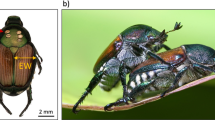Abstract
After being laid on emergent aquatic vegetation, the egg masses ofLethocerus deyrollei are brooded by the male. In laboratory studies, females were observed to destroy egg masses and ingest the fluid of eggs. Brooding males fought with these attackers at first, but then gave up the defense and mated with them. After destroying the egg masses, females laid new ones at the same sites on the same night or the following one, and males brooded the new offspring. The population density of this species is very low. Most males engage in brooding and cease to become acceptable mates after most of the females lay the first egg masses. It is costly for females to search out free males in the aquatic vegetation. By destroying egg masses, however, individual females can gain new mates with little exertion and can make them brood their own offspring. Furthermore, the survival of their own offspring increases with the elimination of their competitors.
Similar content being viewed by others
References
Freed, L. A. 1986 Territory takeover and sexually selected infanticide in tropical house wrens.Behav. Ecol. Sociobiol. 19: 198–206.
Hiraiwa-Hasegawa, M. 1988 Adaptive significance of infanticide in primates.Tree 3 (5) 102–105.
Hrdy, S. B. 1979 Infanticide among animals: A review, classification, and examination of the implications for the reproductive strategies of females.Ethol. Sociobiol. 1: 13–40.
Ichikawa, N. 1985 Breeding ecology of the giant water bug,Lethocerus deyrollei.J. Japan Assoc. Zool. Gard. Aqua. 27(4): 103–106. (In Japanese)
Ichikawa, N. 1988 Male brooding behaviour of the giant water bugLethocerus deyrollei Vuillefroy.J. Ethol. 6(2): 121–127.
Ichikawa, N. 1989 Repeated copulations benefit of the female inLethocerus deyrollei Vuillefroy.J. Ethol. 7(2): 113–117.
Iwahashi, O. 1989 Social behaviour of the subtropical paper waspRoparidia fasciata. In: Social behaviour ofRoparidia paper wasp. pp. 1–209. Tokai Univ. press. (in Japanese).
Polis, G. A. 1984 Intraspecific predation and “infant killing” among invertebrates. In: G. Hausfater and S. B. Hrdy (ed.)Infanticide. pp. 87–104. Aldine New York.
Rankin, K. P. 1935 Life history ofLethocerus americanus (Leidy) (Hemiptera-Belostomatidae).Sci. Bull. XXII 479–491.
Stephens, M. L. 1982 Mate takeover and possible infanticide by a female northern jacana (Jacana spinosa).Anim. Behav. 30(4): 1253–1254.
Author information
Authors and Affiliations
About this article
Cite this article
Ichikawa, N. Egg mass destroying behaviour of the female giant water bugLethocerus deyrollei Vuillefroy (Heteroptera: Belostomatidae). J. Ethol. 8, 5–11 (1990). https://doi.org/10.1007/BF02350123
Received:
Accepted:
Issue Date:
DOI: https://doi.org/10.1007/BF02350123




